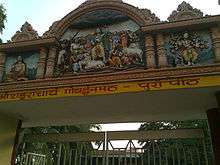Govardhana matha
| Jagadguru Shankaracharya: Sri Nischalananda Saraswati | ||||
|---|---|---|---|---|
 | ||||
| Location | Puri | |||
| Founder | Adi Shankara | |||
| First Acharya | Padmapadacharya | |||
| Formation | 820 AD | - | Present Shankaracharya | Jagadguru Swami Nischalananda Saraswati |
 H.H Jagadguru Swami Nischalanada Saraswati, The Shankaracharya of Puri | ||||
| Website | http://govardhanpeeth.org/ | |||
The Govardhana matha is a monastery located in the city of Puri in Odisha state (India). It is associated with the Jagannath temple[1] and is one of the four cardinal mathas founded by Adi Shankara in the 8th century CE.
The deities here are Jagannath (Bhairava) and the devi is Vimala (Bhairavi). The mahavakya is Prajnana Brahma. There are Shri Vigraha of Goverdhananatha Krishna and Ardhanareshwara Shiva installed by Adi Shankara.[2]
The whole of the Eastern part of the Indian subcontinent is considered as the territory of Sri Govardhan Peeth.[3] This includes the Indian states of Bihar, Jharkhand, Chhattisgarh, Andhra Pradesh till Rajamundry, Orissa, West Bengal, Assam, Arunachal Pradesh, Manipur, Sikkim, Meghalaya, Tripura, Mizoram, and Uttar Pradesh till Prayag. The countries Nepal , Bangladesh and Bhutan are also considered spiritual territory of the math . Puri , Allahabad, Gaya and Varanasi are some of the holy places under this Math.
Background

Govardhana matha is one of four cardinal institutions established by Adi Shankara (c. 8th century CE), the reviver of Vedic Sanatana Dharma.[4] Shankara's four principal disciples, Padma-Pada, Hasta-Malaka, Vartika-Kara and Totakacharya were assigned to these four learning centers in the north, south, east and west of India.[5] The subsequent leaders of each of these four monasteries have come to be known as Śaṅkarāchāryas in honor of the math's founder, Adi Shankara.[6] As such they are the leaders of the Daśanāmī Saṃnyāsins who are considered to have custody of Advaita Vedānta[6] These four principle seats of learning are located in Purī (Orissa), Śṛṅgeri (Karnataka) and Dvārakā (Gujarat) with[6] the northern (Uttarāmnāya) monastery being located in the city of Jyotirmaṭh (also known as Joṣīmaṭh).[6]
History
Padmapadacharya became the first leader of the matha. The matha has historical connections with the Jagannath temple, which is also located in Puri.[1] It is called the Govardhanathatha, and has sub-location called the Sankarananda Math. Swami Bharati Krishna Tirtha, who was then the leader at the Dvaraka matha, assumed the leadership position at the Govardhana matha in 1925; Shankara Prushottama Tirtha supervised the Matha on his behalf while he visited the Self Realization Fellowship in the USA.[1] After Bharati attained Mahasamadhi in 1960, Yogeswaranda Tirtha succeeded him who also attained Mahasamadhi a year later in 1961. In 1964, after a "period of uncertainty" Niranjana Deva Tirtha, a disciple named in Bharati's will, was installed by Aghinava Saccindananda Tirtha of Dvarka.[1] Nirnjana Deva Tirtha became known for his unpopular political views affecting the Hindu people.[7] In 1992, he stepped down after nominating Niscalananda Saraswati as his successor in the 1990s.[1][8]
Samudra Arati

The Samudra arati is a daily tradition started by the present Shankaracharya 9 years ago.[2] The daily practise includes prayer and fire offering to the sea at Swargadwar in Puri by disciples of the matha. On Paush Purnima of every year the Shankaracharya himself comes out to offer prayers to the sea.
See also
References
- 1 2 3 4 5 Unknown author (May 5, 1999) archived here (Accessed: 2012-08-30) or here The Monastic Tradition Advaita Vedanta web page, retrieved August 28, 2012
- 1 2 Sahu, Monideepa (6 March 2016). "The great fire". Deccan Herald. Retrieved 6 March 2016.
- ↑ Vaidya, Dhananjay (17 August 2008). "Poorvamnaya Sri Govardhan Muth, Bhogavardhan Peetham, Puri". Organiser. Retrieved 16 November 2015.
- ↑ Pasricha, Prem C. (1977) The Whole Thing the Real Thing, Delhi Photo Company, p. 59-63
- ↑ Love and God, Maharishi Mahesh Yogi, Age of Enlightenment Press, 1973 p. 9
- 1 2 3 4 Unknown author (2005) Indology The Jyotirmaṭha Śaṅkarācārya Lineage in the 20th Century, retrieved August 4, 2012
- ↑ http://www.rediff.com/news/2000/aug/28sankra.htm
- ↑ (1994) SUNY Press, A Survey of Hinduism By Klaus K. Klostermaier